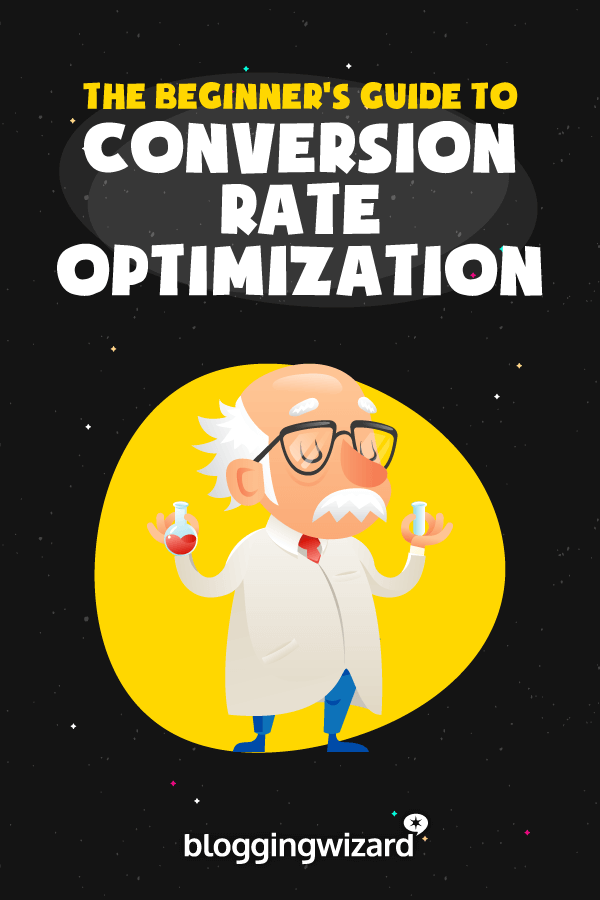What Is Conversion Rate Optimization? A Quick Guide For Beginners

Entrepreneurs are usually focused on driving new traffic to websites, content, and landing pages.
The objective? More revenue.
But what if you could 3x revenue without any new traffic at all?
Well, you can and here’s how:
Optimize your website for conversions using basic conversion rate optimization (CRO) principles.
Here’s the good news:
Getting started is easier than you might think. And, in this post, you’ll learn what conversion rate optimization is, how it can boost your website’s revenue, where to start on your blog, and more.
Let’s dive right in:
What is conversion rate optimization?
Conversion Rate Optimization, also known as CRO, is a process that enables people to take some sort of action when they’re on a website. By changing certain elements of a page, a business will increase its chance of getting a “conversion” and turning a visitor into a lead.
Conversions don’t happen in just one place. They can happen on a pricing page, a home page, a landing page, or a blog. By simply optimizing these pages for a higher number of conversions, the leads will start pouring in.
To get those conversions, though, you have to go through the process of CRO.
How can it boost your website’s revenue?
Your website’s conversion rate should be a key element in your online sales strategy. Even if you don’t account for it, it’s making a big impact on your website’s revenue. After all, if you’re never turning those interested parties into your buyers at an efficient rate, what’s the point of all your digital sales and marketing efforts?
When you optimize your conversion rate, you are maximizing upon the traffic that is already coming to your site. Rather than having to pay to bring more traffic in, you’re simply taking advantage of the traffic you have more effectively.
With proper CRO, the percentage of your prospects that take action will increase. Then, the percentage of prospects that become paying customers will increase. When you can double or triple your conversion rates, you will see more qualified leads, more frequent sales, and increased revenue.
Where to start on your blog – The 80/20
The 80/20 rule is a concept that comes from Vilfredo Frederico Damaso Pareto. The legend goes that one day, this man noticed that 20 percent of his garden’s pea plants were generating 80 percent of the healthy pods. After seeing similar patterns in distribution and production, the general concept became this:
’80 percent of any kind of results will come from 20 percent of the input or action taken.’
This rule can be applied to CRO.
When you’re getting started on your blog, it’s easy to pour all of yourself into it. After the content is up for a while, you’ll likely notice that around 20 percent of your blog posts are bringing in 80 percent of the traffic.
It’s also likely that 20 percent of your traffic that is bringing in 80 percent of the conversion. Do you see where we’re going with this?
To be as effective as possible in your CRO, you’ll want to zoom in on that profitable 20 percent:
- The 20 percent of page areas that are getting the most clicks
- The 20 percent of your viewing audience who is most likely to buy
- The 20 percent of content that is bringing in 80 percent of the conversions
These are your key pages and your key elements.
Determining your key pages and elements
To get started with CRO, you first must identify the key pages and areas within pages that are converting the most. Finding this information can be tricky, but Google Analytics will make it easy.
Google Analytics is a great tool that provides a detailed look at who is visiting your page, what their behaviors are, and what areas are getting the most action. It will give you insight into:
- How a visitor is interacting with your site
- When and where they’re leaving the site
- Which pages are thriving while others are struggling
It can also provide heat maps, which offer further data about how your pages and content are being consumed.
Once you collect your data, you’ll want to watch for trends and patterns amongst the results. In highlighting the trends, you’ll see which pages and elements of your website you should be focusing your attention on. In addition to what you find, you could also consider these areas of high impact to test:
- Product comparison table
- Pros and cons list within mini product reviews
- CTA buttons – copy, color, placement
- Images – product images vs. no product images, illustration vs. photo, etc.
From here, you’ll need to create your hypotheses, which will outline your upcoming tests as you dive into the meat and potatoes of CRO. For example, you could hypothesize that shortening a certain form will increase purchases by a certain percentage because it will make the check-out process that much smoother.
With your hypotheses ready to go, you can begin A/B testing.
What is A/B testing and how can you implement it?
A/B testing is also called split testing. This method uses two (or three, or four) versions of a website page to see which version performs better. The performance is judged upon a previously formulated hypothesis. Here’s how the A/B process works:
- You pick the element to test
- You make a small change that you hypothesize will improve conversions
- You test the control (original version) against the variant (the new version) by sending half of your traffic to one place and half to the other
- You look at the data of conversion rates on each page
- Whichever page had higher conversion is the version that goes on to live on the website
- Repeat with slightly different angles or elements
One of the best parts of A/B testing is that it puts theory to the side and looks at what actually works with your traffic — no more shots in the dark. Now, you get to see the proof for yourself.
Note: You’ll find A/B testing functionality in various marketing tools. From email list plugins and landing page plugins to email marketing services. But do you need to use paid tools? Nope – If you want to A/B test pages on your website you can get started using VWO.
Analyzing your A/B testing data
After your split test has run for a while (maybe a month or so), you should have enough data to get an idea of how the hypothesis worked out.
You don’t want to just look at page views. Remember: what we’re going for here is the conversion of the traffic you have, not the amount of traffic you’re getting. Rather, you want to look at page views AND total clicks.
This can’t just be any click. This needs to be THE click that converts a visitor into a lead. That could be a “buy now” button, or it could be an email-opt in form. Whatever kind of conversion you’re looking for here is what you should be measuring.
Using the hypothesis we created above, that shortening a billing form would increase the conversion of buyers, we want to look at:
The percentage of visitors that completed the buying process on the original version vs. visitors who completed the buying process on the new version.
To get that, we’d need to divide the number of total visitors by the number of completed buyers.
Then, we can compare the two conversion percentages to see if our hypothesis was correct.
Coming to conclusions & proceeding forward for success
After you complete a few A/B tests, you’ll see just how much CRO can impact your bottom line. You’ll be able to create better versions of your website pages and slowly transform your entire online conversion results.
Realize that this needs to be an integral part of your marketing strategy.
In moving forward, we want to offer a few final tips as you continue optimizing your site and growing your business.
Without further ado, here are three tips in moving forward with CRO:
- Think creatively about your website. You can try things like adding text CTAs in blog posts or including lead flows within a blog. Get creative about how you can optimize your conversion rate based on your user interaction.
- Prioritize your CRO using the 80/20 rule. Remember to spend your time on the 20 percent that will bring about 80 percent of the results.
- Put someone in charge of CRO. If you don’t have the role already on the team, add one!
Conclusion
While it might sound pretty overwhelming at first, just remember that CRO comes down to having a finely tuned process. Once the process and workflow are all set up, you will have a smooth running and optimized site. And creating your process becomes a lot easier after going through a top of the line CRO Training Program.
By creating a CRO process that works for the day-to-day reality of your business, you’ll set yourself up for success. Instead of struggling to bring in new traffic for your sales team to convert, focus on maximizing the traffic you have with CRO.

